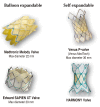Recent advances in pediatric interventional cardiology
- PMID: 29042864
- PMCID: PMC5638720
- DOI: 10.3345/kjp.2017.60.8.237
Recent advances in pediatric interventional cardiology
Abstract
During the last 10 years, there have been major technological achievements in pediatric interventional cardiology. In addition, there have been several advances in cardiac imaging, especially in 3-dimensional imaging of echocardiography, computed tomography, magnetic resonance imaging, and cineangiography. Therefore, more types of congenital heart diseases can be treated in the cardiac catheter laboratory today than ever before. Furthermore, lesions previously considered resistant to interventional therapies can now be managed with high success rates. The hybrid approach has enabled the overcoming of limitations inherent to percutaneous access, expanding the application of endovascular therapies as adjunct to surgical interventions to improve patient outcomes and minimize invasiveness. Percutaneous pulmonary valve implantation has become a successful alternative therapy. However, most of the current recommendations about pediatric cardiac interventions (including class I recommendations) refer to off-label use of devices, because it is difficult to study the safety and efficacy of catheterization and transcatheter therapy in pediatric cardiac patients. This difficulty arises from the challenge of identifying a control population and the relatively small number of pediatric patients with congenital heart disease. Nevertheless, the pediatric interventional cardiology community has continued to develop less invasive solutions for congenital heart defects to minimize the need for open heart surgery and optimize overall outcomes. In this review, various interventional procedures in patients with congenital heart disease are explored.
Keywords: Catheterization; Congenital heart disease; Intervention.
Conflict of interest statement
Conflict of interest: No potential conflict of interest relevant to this article was reported.
Figures



References
-
- Kim SH. Interventional catheterization in congenital heart disease. Sejong Med J. 1992;9:143–148.
-
- Kang IS. Recent advance of interventional catheterization in congenital heart disease. J Korean Pediatr Soc. 2003;46:1178–1185.
-
- Kim SH. Therapeutic catheterization in congenital heart diseases. Korean J Pediatr. 2004;47(Suppl 1):S150–S158.
-
- Choi JY. Recent advances in transcatheter treatment of congenital heart disease. Korean J Pediatr. 2006;49:917–929.
-
- Crystal MA, Ing FF. Pediatric interventional cardiology: 2009. Curr Opin Pediatr. 2010;22:567–572. - PubMed
Publication types
LinkOut - more resources
Full Text Sources
Other Literature Sources

